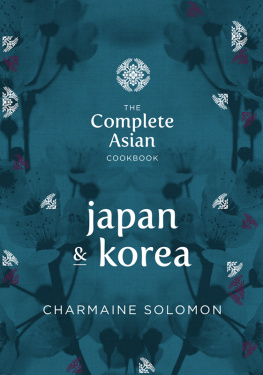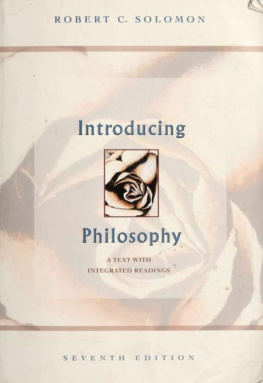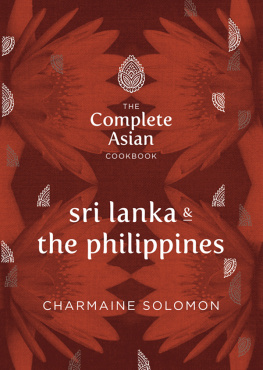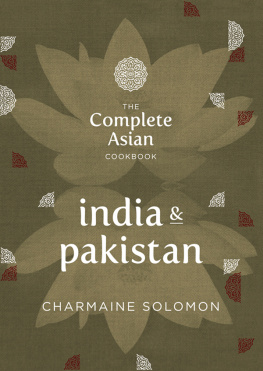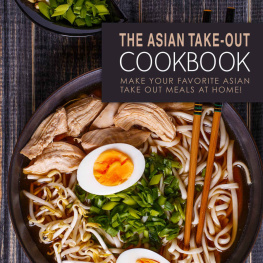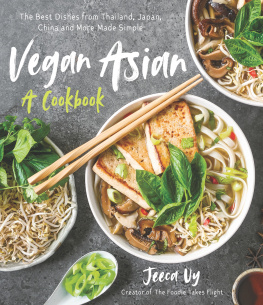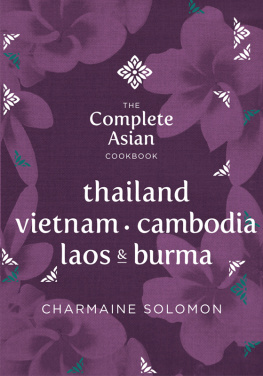To Reuben, who married me before I learned to cook.

Completely revised and updated in 2011
First published in 1976
This edition published in 2013 by Hardie Grant Books
| Hardie Grant Books (Australia) | Hardie Grant Books (UK) |
| Ground Floor, Building 1 | Dudley House, North Suite |
| 658 Church Street | 3435 Southampton Street |
| Richmond, Victoria 3121 | London WC2E 7HF |
| www.hardiegrant.com.au | www.hardiegrant.co.uk |
All rights reserved. No part of this publication may be reproduced, stored in a retrieval system or transmitted in any form by any means, electronic, mechanical, photocopying, recording or otherwise, without the prior written permission of the publishers and copyright holders.
The moral rights of the author have been asserted.
Copyright text & design Hardie Grant Books
Copyright photography Alan Benson
A Cataloguing-in-Publication entry is available from the catalogue of the National Library of Australia at www.nla.gov.au
The Complete Asian Cookbook: Japan & Korea
eISBN 9781743581698
Publishing Director: Paul McNally
Project Editor: Rihana Ries
Editor: Ariana Klepac
Design Manager: Heather Menzies
Design Concept: Murray Batten
Photographer: Alan Benson
Stylist: Vanessa Austin
Production: Todd Rechner
Find this book on Cooked.
Contents

Just as France has its robust country fare as well as its subtle haute cuisine, so too does Asia have a range of culinary delights that can be simple, complex, fiery, mild, tantalising and compulsive! Not all Asian food is exotic or wildly unusual. Noodle and rice dishes are as commonplace as the pastas and potatoes of the West. Many of the ingredients will be familiar to anyone who knows their way around a kitchen. The main differences have arisen just as they have arisen in other parts of the world through the use of available ingredients. Thus there is a reliance on some herbs and spices less well known in the West. Meat is often replaced by the nutritious by-products of the soy bean and by protein-rich fish sauces and shrimp pastes.
True, some of the more unusual ingredients take a little getting used to. But once you have overcome what resistance you may have towards the idea of raw fish or dried shrimp paste or seaweed, youll find that these (and other) ingredients are no less delicious than and certainly as exciting as those you use in your favourite dishes.
The introduction to these countries will give you a good idea of what to expect in the way of out-of-the-ordinary ingredients. Almost without exception, those called for are readily available in most large supermarkets or Asian grocery stores; in the rare case they are not, suitable substitutes have been given.
Those of you already familiar with Japanese and Korean cuisine will, I hope, find recipes to interest and excite you in these pages; and I think you will be tempted to explore dishes with which you are less well acquainted. For those of you who are coming to Japanese and Korean cooking for the first time, I have taken care to make sure the essential steps are clear and precise, with detailed instructions on the following pages for cooking the much-used ingredients (such as rice, noodles and chilli), and pointers on how to joint a chicken, portion fish and select and season a wok.
For most recipes, the names have been given in the dominant or most common language or dialect of the country concerned, followed by the English name in italics. Generally, the letter a in Japanese and Korean words is pronounced as the a in father, never as in cat; and the letter u is rather like the oo in look, never as in duty.
Eating for health
Most Asian food is healthy. Many spices and ingredients such as garlic and ginger have proven health-giving properties. However, with todays emphasis on weight control I have made modifications in the quantity and type of fat used for cooking. I have found it is possible to get very good results using almost half the amount of fat called for in many traditional dishes.
All of these recipes are adaptable to low-fat diets with very little sacrifice of flavour, since most of the exotic tastes come from herbs, spices and sauces.
Cooking with a wok
If I had to choose one cooking pan to be marooned on a desert island with, Id choose a wok. It would cope with any kind of food that happened to be available. In it you can boil, braise, fry and steam, and while you can do all these things in pans you already possess, the wok is almost indispensable for the stir-frying technique that many Asian dishes call for. Because of its rounded shape and high, flaring sides you can toss with abandon and stir-fry ingredients without their leaping over the sides; and because the wok is made of thin iron you get the quick, high heat necessary to much Asian cooking.
Though a wok is best used with gas, it is possible to get good results with electricity. Because quick, high heat is required in stir-frying, turn the hotplate on to the highest heat and place the wok directly on it; it is possible to buy woks with a flat base for better contact, or invest in an electric wok where the heating element is built into the pan. The 3035 cm (1214 in) wok is most useful. You can cook small quantities in a large wok, but not vice versa.
The wok made of stainless steel is a modern innovation, but a modestly priced iron wok heats up quickly and evenly and, if you remember to dry it well after washing, it will not rust.
Before use, an iron wok must be seasoned. Prepare it by washing thoroughly in hot water and detergent. Some woks, when new, have a lacquer-like coating, which must be removed by almost filling the wok with water, adding about 2 tablespoons bicarbonate of soda (baking soda) and boiling for about 15 minutes. This softens the coating and it can be scrubbed off with a fine scourer. If some of the coating still remains, repeat the process until the wok is free from any lacquer on the inside. To season the new wok, dry it well, put over gentle heat and, when the metal heats up, wipe over the entire inner surface with some crumpled paper towel dipped in peanut oil. Repeat a number of times with more oil-soaked paper until the paper stays clean. Allow to cool. Your wok is now ready for use.
After cooking in it, do not scrub the wok with steel wool or abrasives of any kind. Soak in hot water to soften any remaining food, then rub gently with a sponge, using hot water and detergent this preserves the surface. Make sure the wok is quite dry, because if moisture stays left in the pan it will rust. Heat the wok gently to ensure complete dryness, then rub over the inside surface with lightly oiled paper. A well-used wok will soon turn black, but this is normal and the more a wok is used, the better it is to cook in.
Deep-frying
A wok is an efficient pan for deep-frying as it has a wider surface area than a regular frying pan. Be sure that the wok is sitting securely on the stove. Fill the wok no more than two-thirds full and heat the oil over medium heat.
To check the temperature for deep-frying, use a kitchen thermometer if you have one on average, 180C (350F) is the correct temperature. To test without a thermometer, a cube of bread dropped into the oil will brown in 15 seconds at 180C (350F), and in 10 seconds if the temperature is 190C (375F).

